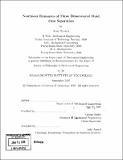Nonlinear dynamics of three dimensional fluid flow separation
Author(s)
Surana, Amit
DownloadFull printable version (20.31Mb)
Alternative title
Nonlinear dynamics of 3D fluid flow separation
Other Contributors
Massachusetts Institute of Technology. Dept. of Mechanical Engineering.
Advisor
George Haller.
Terms of use
Metadata
Show full item recordAbstract
Flow separation (the detachment of fluid from a no-slip boundary) is a major cause of performance loss in engineering devices, including diffusers, airfoils and jet engines. The systematic study of flow separation dates back to the seminal work of Prandtl in 1904. He showed that a two-dimensional steady flow separates from a no-slip boundary at points where the wall shear vanishes and admits a negative gradient. Three-dimensional flows, however, tend to separate along lines, as opposed to isolated wall-shear zeros. Despite widespread effort, no generally applicable extension of Prandtl's result has emerged for even three-dimensional steady flows. In this thesis we develop a nonlinear theory for separation and attachment of steady and unsteady three-dimensional fluid flows on no-slip curved moving boundaries. The theory provides analytic criteria for locating the separation line and approximating the shape of separation surface. Based on nonlinear dynamical systems techniques, the criteria identify separation line and separation surface by locating nonhyperbolic unstable manifolds that collect and eject fluid particles from the boundary. We verify our theory on analytic flow models, in numerical simulations of important benchmark problems and in experiments. Our theory provides a systematic tool for diagnostics, configuration design and active flow control of separation and attachment in complex three dimensional fluid flows.
Description
Thesis (Ph. D.)--Massachusetts Institute of Technology, Dept. of Mechanical Engineering, 2007. Includes bibliographical references (p. 241-248).
Date issued
2007Department
Massachusetts Institute of Technology. Department of Mechanical EngineeringPublisher
Massachusetts Institute of Technology
Keywords
Mechanical Engineering.